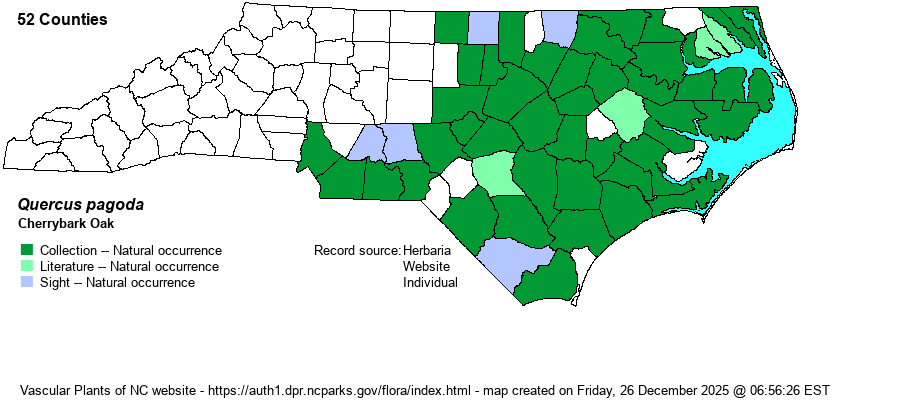| Author | Rafinesque | |
| Distribution | Throughout the Coastal Plain and the southeastern third of the Piedmont; occurs west to Caswell and Mecklenburg counties. Not confirmed from the Mountains and western half of the Piedmont, though there are a few unconfirmed reports from these regions.
This is a Southeastern species, ranging north to eastern VA (if not also MD and DE) and southern IL, and south to northwestern FL and eastern TX. It is essentially absent from montane regions.
| |
| Abundance | Frequent to common in the Coastal Plain, though mostly in brownwater floodplains; infrequent in the Sandhills, however. Can be infrequent in some counties in that province that lack brownwater rivers or other rich alluvial soils. Fairly common, at least locally, in the southeastern Piedmont, but uncommon in the central counties. Can be common in a few Piedmont sites along large/wide floodplains. | |
| Habitat | This is primarily found in bottomland forests, preferring (but not restricted to) brownwater floodplains. It also can occur in some rich or high pH flats, but only rarely does it occur in uplands, and then only where the soil is very rich. It is a frequent “companion” with Swamp Chestnut Oak (Q. michauxii) and in some places with Willow Oak (Q. phellos), which has a wider range of habitats. | |
| Phenology | Flowers in April and May; fruits from September to November of the second year (one year after flowering). | |
| Identification | This is a familiar large deciduous tree (to people in the eastern half of the state), often reaching 100 feet tall or taller. It has medium to large leaves that are usually distinct from other species, even though for much of the 20th Century is was considered only as a variety of Southern Red Oak (Q. falcata). However, Cherrybark Oak leaves resemble a Chinese pagoda when turned with the petiole up -– being rather straight sided and angled diagonally at the base, and with several deep but triangular sinuses on each side, yielding several triangular lobes. The lobes are often squared at the ends instead of pointed, but you should be able to find some or many leaves on a given tree with the typical triangular sinuses and lobes. There are also a few other characters for separation, such as bark, acorn, etc., but most people can identify it by the leaves. The bark is dark brown-gray and rather tight, with narrow vertical plates. | |
| Taxonomic Comments | Most biologists are fully aware that for much of recent history, the taxon was generally named as a variety -– Quercus falcata var. pagodaefolia. However, in recent decades nearly all references do consider the taxon as a valid species, as Q. pagoda.
| |
| Other Common Name(s) | Pagoda Oak, Swamp Spanish Oak | |
| State Rank | S5 | |
| Global Rank | G5 | |
| State Status | | |
| US Status | | |
| USACE-agcp | FACW link |
| USACE-emp | FACW link |

